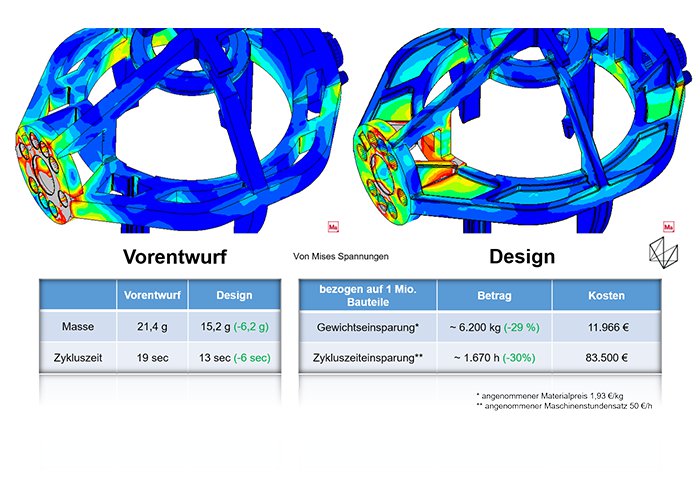
From draft to design by means of FE analyses in Marc
ESPECIALLY FOR OUR USERS
Today's product development does not exclusively include requirements for lightweight construction or material savings. Many companies also focus on the development time with regard to costs. By using FE analyses, optimizations for a successful design of a product can be made directly in the preliminary design phase.
In the course of the recent past, a change in the requirements for product development can be observed. By default, the requirements according to the specifications have always been the top priority on the technical side. When looking at the last years, further aspects as well as necessary requirements have increased in their priorities. The focus on the environment and sustainability took on a new significance, which influences the corresponding costs.
In the development of a product, the balance between manufacturability, intended use, service life and overall costs must be maintained. In order to reduce prototypes together with the experimental tests, the common CAE tools for the individual disciplines are available on the market. As things stand today, process behavior and manufacturability can be demonstrated via an injection molding simulation in Moldex3D, whereas the nonlinear structural-mechanical analysis can be performed in an MSC Marc. With the step of integrative simulation or coupling with multiscale material modeling, influences from the manufacturing process can be considered in the mechanical behavior of the product under complex material behavior. By generating realistic results, it is possible to initiate concrete and target-oriented optimizations or remedial measures.
In the field of product development, insight into the internal component behavior by means of simulations is essential. The use during the design phase of a product does not only offer the reduction of iterations in tool making or process settings, but flows directly into the quality improvement of the product.
The cover picture shows a real component in the preliminary design phase and the pre-production design. Using injection molding simulation, the manufacturability as well as the process behavior was proven. Furthermore, an analysis of critical areas such as weld lines and residual stresses on the part was quantified and qualified. A transfer of the process-induced properties to the structural mechanics is possible at any time and approximates the calculation results to the real component behavior. In the subsequent structural mechanics FE analysis, a static stiffness and strength analysis was performed, which resulted in an overdimensioning of the structure. The FE results were used to analyze the component behavior under service conditions. As a result, an overdimensioning of the structure could be proven after a calculation and subsequent optimization measures could be initiated. This resulted in a topology optimization of the component with added value in several areas. On the one hand, significant material savings and the associated cycle time optimization with savings in machine or manufacturing costs and, on the other hand, a better force flow with low stress and strain concentration and distributions could be implemented.
The case study shows that not only costs and production time were saved, but also product quality and service life were increased. Also to be mentioned is an increased development time, which is finally completely offset by fewer iterations, sampling, experimental testing and represents a further cost saving. Additionally, goals of CO² neutrality as well as sustainability will be easier to achieve.
The virtual development process demonstrated a successful transition from a preliminary design to a pre-production component or product design. Finally, further optimizations can be made, as the savings potential showed further potential after a virtual iteration from simulations.
